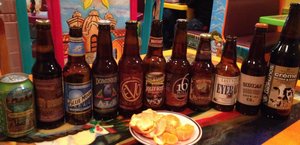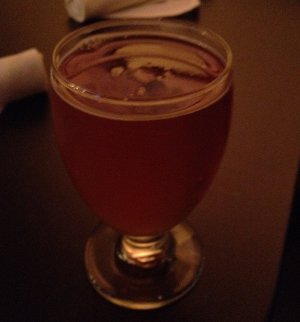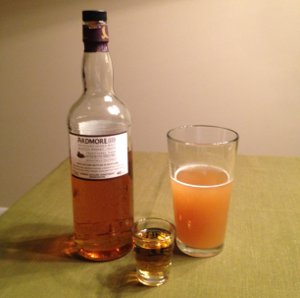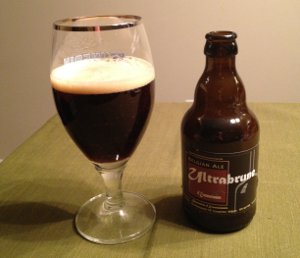Tonight was beer club, a meeting of beer minded individuals from my work who get together for a meal and lots-o-beer once a month. An interesting turnout this month, as a few stalwarts were absent, but new attendees picked up the slack. This time around, we visited a Mexican BYOB with quite the ostentatious decor:
Phew, that place has some brightly colored furniture. But amazing salsa and good food too. For the sake of posterity, some thoughts on each beer we tried are below. As usual, conditions were not ideal, so you can and should be skeptical of my notes. In order of drinking (not in order of the picture above):
- Lagunitas Hairy Eyeball Ale - Wow, very rich malt flavors here, like a Scotch ale, but with something more. I got a distinct barrel aged character out of it, though this not one of those versions (apparently there are bourbon, port or brandy barrel aged versions, which I'd love to try). Fantastic beer, got the night going in style, though it may have set the bar unreasonably high for the following beers. I'd love to get me some more of this. A candidate for best of the night. A-
- Appalachian Jolly Scot Scottish Ale - A somewhat local PA beer, this is another malt-forward ale that, unfortunately, didn't stand up too well to the Hairy Eyeball. It was fine, to be sure, and I'd probably really enjoy one of these by itself, but it came off as being a biton the thin side after the rich flavors of the Hairy Eyeball. B
- Blue Moon Belgian White - I know, it's brewed by Coors, but hey, it actually worked really well at this point in the night. After two malt forward beers, it was a really refreshing change of pace, and I honestly have no problem with this beer anyway. Obviously not something I would ever go out of my way for, but a lot of places that only stock macros will have this on tap, and it's actually a nice beer. No, it won't melt your face, but it's a good gateway beer. Lots of wheat and citrus, it's refreshing and made for a nice palate cleanser tonight. B
- Tommyknocker Imperial Nut Brown Ale - Big brown ale brewed with Maple Syrup, you do get that character coming through pretty strongly here. A big, rich ale, no real hop presence, but lots of malts and that maple syrup adds a nice richness to the proceedings. Very well done, and another candidate for best of the night. A-
- Sierra Nevada Ruthless Rye IPA - Well hopped (citrus and a little pine), plenty of balancing malts, and some of that distinctive rye character (though I never got the full-on rye bread character people seem to talk about). It didn't blow my mind, but a very solid beer that I could probably drink often. B+
- St. Bernardus Prior 8 - Not pictured (late arrival), but it's a classic. Already reviewed here.
- Southern Tier Creme Brulee (Imperial Milk Stout) - Another beer I reviewed a while back, this is one of the more interesting beers of the night. Massive aroma, intense flavors of chocolate, caramel, vanilla, maybe even some coffee. I could just sniff this stuff all night. Great stuff, maybe even a little better than I remember (though I think my chief complaint last time was that it's a bit too sweet to drink a whole bottle). A strange beer because I wouldn't call it one of my favorites, but it's so distinctive and interesting that I'd highly recommend it to just about anyone. A great dessert beer.
- Dominion Ale - Any beer that follows the intense flavors and aroma of Creme Brulee was probably doomed to failure, and this turned out to be a rather standard English Pale Ale, a style I'm coming to dislike quite a bit these days. I always feel like there are buttery off flavors in these beers, and this one is no exception. I even threw in a small slice of orange, which helped mellow it out a bit, but blegh. Not a fan of this beer. D
- Kaedrin Christmas Ale - My homebrewed winter warmer style beer (a kinda spiced red ale), this thing has to be my best beer yet. Very nice spicy aroma, picking up lots of that cinnamon and clove, tastes quite nice, almost creamy mouthfeel. I really hope this wasn't some sort of fluke. I should really do a recap of all my homebrews at some point on the blog, so no rating for now, but I would seriously put this up against any of the winter warmer style beers I've had over the past couple years.
- Boxcar Brewing A Long Winter's Night - This is probably as local as I can get. The (tiny) brewery was literally a few blocks away from where we were tonight (and this limited edition brew doesn't even warrant a page on BA, apparently). This winter ale was very interesting. I didn't get a lot of spice or anything out of it, but it was a very nice cloudy brown color with... it's hard to describe. Roasted chocolate? But not at all like a stout. More like a brown ale, but with no coffee and some chocolatey overtones (to be honest, it's very much like their regular brown ale, but perhaps less nutty). Very solid beer. B






 On the first Friday of every month, there's a beer blog roundup called
On the first Friday of every month, there's a beer blog roundup called 
Recent Comments